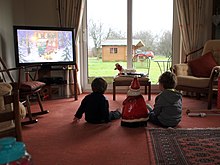Relational goods
[2] Adam Smith, in his 1759 work The Theory of Moral Sentiments, first outlined the idea of non-instrumental relational positives.
[4] The 18th century Italian tradition of Civil Economy put the concept of the inner relational nature of the person at the core of the economic science.
The idea was largely abandoned until the 1970s by the mainstream (although we can find intuitions in Mill, Marshall, the Austrian school, Keynes, Hirschman), when the discussion of happiness again came to light with the first analysis of the Easterlin Paradox.
A solid concept of relational goods was built in the following years in an attempt to reconcile this paradox, and to answer the issue of why voter turnout is higher than rational choice theory suggests.
Economists adopted this concepts, and began to involve relational analysis to study what creates happiness for individuals.
Due to the highly intangible nature of this connection, relational goods and their value is difficult to measure, and thus study.
[7] Many studies instead measure social interactions (volunteering, clubs, church events, parties and gatherings etc.)
What is infinitely clearer is that deprivation of human interaction can have drastic negative effects physiologically, which aids the hypothesis that relational goods at the very least have health-related utility.
In contrast, relational goods are produced in sympathetic, empathetic, trusting, and high regard relationships referred to here and by others as social capital.
Easterlin theorized that crowding out concept, where pursuit of increased wealth has a negative effect on non-material goods like maintaining relationships.
Becchetti, Londono Bedoya and Trovato[9] found in 2009 that at the highest income levels, time for relationship is negatively affected.
This supports previous research that has shown that increased television time is negatively correlated to life satisfaction.
[15] Policies like increasing access to public spaces for collaboration, providing opportunities for volunteering or other sociable activities, all help that may improve well-being.
This is concurrent with other research that has proven women to be more empathetic, an emotion that lends itself well to socialization and may be considered a relational good.
While education significantly improves choice in material goods, the traditional yardstick for happiness, it does less to improve your options in relational goods, and may in fact reduce your options as more educated people tend to work longer hours,[22] thus leaving less time for relationships.

